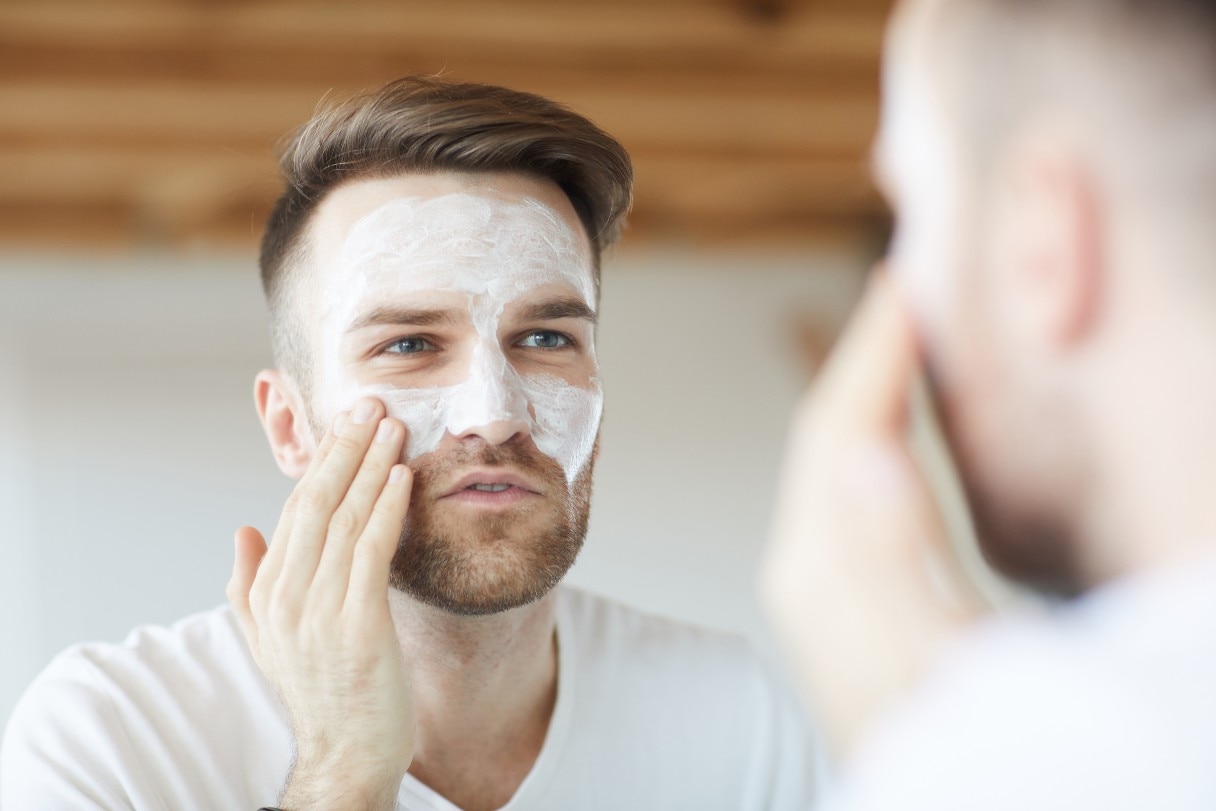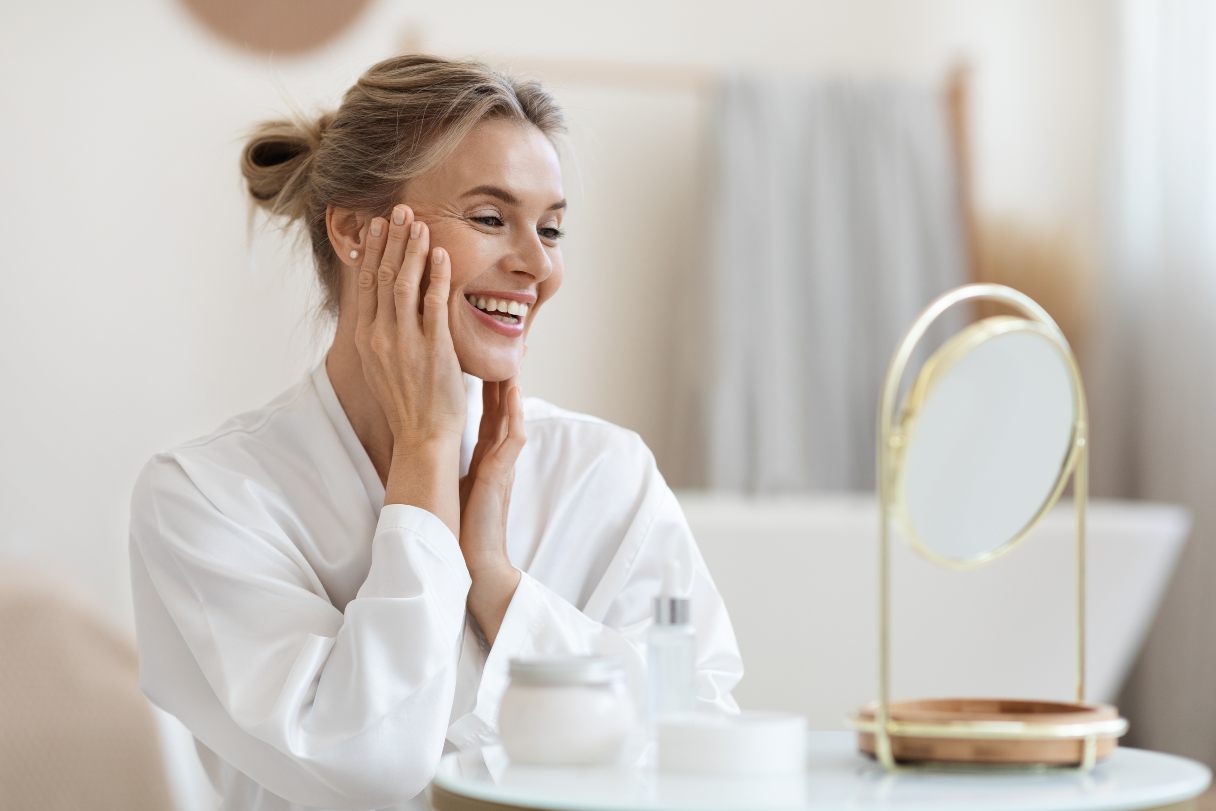If your face is red and has inflamed bumps and vessels, you may have rosacea.1 This condition can be physically uncomfortable and can also affect people's self-esteem1 —which makes finding effective, different treatment options extremely important. Read on to learn more about this skin condition that affects as many as 16 million Americans.2
What Is Rosacea?
Rosacea is a condition of the facial skin that causes red, inflamed bumps and vessels and inflammation of the sebaceous glands; it is considered both chronic and inflammatory.1 People with this condition have skin that often looks red and irritated, a term known as “erythema,"3 and their skin will contain lesions, pustules or papules (essentially, lumps and bumps and pus-filled pimples).4 Patients may describe the sensations of rosacea as being itchy, burning, stinging and/or tight.5
Though rosacea can affect a wide range of ages, in a recent study, those aged 60 to 70 years old showed a prevalence nearly 20 times higher than those in the 16- to 29-year-old bracket.1
Additionally, rosacea is often seen in conjunction with other conditions, such as hemangiomas (red or purple vascular bumps6), spider veins and other vascular lesions, which, the same study suggested, means rosacea patients should be closely examined and monitored to prevent these comorbidities.1
Common Types of Rosacea
Rosacea can be hard to diagnose in its early stages because it can resemble other kinds of rashes and even acne. Though it is more common in people with lighter skin complexions, it does occur in people with darker skin but can sometimes be harder to diagnose. It is more likely to occur in women, but men may get more severe cases.8
Rosacea is commonly categorized into four types:7
- Type 1 (Vascular rosacea): Mainly redness of the face with some visible small blood vessels
- Type 2 (Inflammatory rosacea): In addition to facial redness, papules (bumps), lumps and pus-filled pustules may occur.
- Type 3 (Phymatous rosacea): The skin begins to thicken and become bumpier, especially on and around the nose, which can become enlarged and bulbous.
- Type 4 (Ocular rosacea): Inflammation primarily of the eyes and eyelids (blepharitis), often without any other skin symptoms
Rosacea Symptoms
Symptoms of rosacea include:8
- Facial redness. The redness of rosacea doesn't always come on in a dramatic way. It could appear as a persistent flushing of the skin that remains over time. The flushing may tingle or burn, and the skin may become rough or even scaly.
- Rash. Rosacea can simply appear as a red rash, or it can be redness plus bumps that look like pimples and often contain pus.
- Visible blood vessels. If more than a few blood vessels are visible on the face, this may be a sign of rosacea.
- Skin thickening. A common symptom of rosacea is for the skin of the face to thicken, particularly around the nose, which can make the nose look enlarged or bulbous. This is more likely to affect men.
- Eye irritation. Rosacea can even affect the eyes, known as ocular rosacea, causing them to be painful, itchy, excessively watery or dry. Swelling may occur at the base of the eyelids, and this may lead to more frequent styes. These require immediate medical attention to prevent loss of slight.
Rosacea Causes
Rosacea's causes aren't fully understood by medical research.1 However, it is believed to result from a dysregulation of the immune system.1 Possible triggers can include food and drink, such as alcohol and spicy foods; environmental causes, such as exposure to UV light; and genetic or family history.1 There is also some association with the disease and certain mites1 or bacteria, but a direct cause hasn't been identified.4 Additionally, people with conditions such as obesity, inflammatory bowel disease and those who smoke are more likely to develop rosacea.4
Treating Rosacea With Topical Medications
Many treatments exist for rosacea. There are six topical treatments that have been approved by the U.S. Food and Drug Administration (FDA):4
- Azelaic acid. A natural dicarboxylic acid, this 15% gel is prescribed to treat mild-to-moderate rosacea. Continuous use over 15 weeks showed remarkable improvement.
- Metronidazole. When applied once daily, this antibiotic — typically prescribed in either a 0.75% to 1% gel, cream or lotion — significantly reduced erythema and inflammatory lesions.
- Sodium sulfacetamide/sulfur. Applied in combination as a 10%/5% gel, cleanser, lotion, suspension and/or cream, these two drugs have an anti-inflammatory effect on the redness and inflammatory lesions of rosacea when applied for over eight weeks.
- Brimonidine tartrate. When applied as a 0.33% gel, this α-adrenergic receptor agonist has an anti-inflammatory effect on rosacea through vasoconstriction (shrinking) of subcutaneous vessels after about one month's use.
- Oxymetazoline hydrochloride. This potent α-1 agonist in 1% cream, applied once daily, begins to reduce inflammation within as little as three hours after application, lasting up to 10 hours.
- Ivermectin. This antiparasitic cream in 1% strength, applied once daily, is useful in cases of rosacea where the microbe D. folliculorum is present.
Possible side effects or risks of topical medications
Each aforementioned topical treatment does have side effects, the most common being burning, itching and dryness. The broader variety of additional side effects and potential risks for each treatment are outlined below.
- Azelaic acid: burning or tingling sensation that should go away, or possible lightening of the skin9
- Metronidazole: itching, stinging, irritation or dryness at the points of application9
- Sodium sulfacetamide/sulfur: itching, dryness, redness or irritated skin9
- Brimonidine tartrate: skin redness, flushing or skin lightening; severe side effects can include dizziness, a slow heartbeat or a burning sensation10
- Oxymetazoline hydrochloride: blistering, crusting of the skin, cracking or dry/scaly skin, swelling at the point of application and worsening of rosacea pimples11
- Ivermectin: side effects tend to be rare but can include burning, itching, redness, dandruff, dry skin, eye tearing or swelling of the inner eyelid12
A promising new topical treatment option for rosacea
According to the National Rosacea Society, there's an exciting new treatment option for rosacea that shows promise. EPSOLAY®, a 5% benzoyl peroxide (BPO) cream, is touted as the first of its kind to microencapsulate BPO in silica to reduce the “bumps and blemishes" of rosacea. BPO was previously considered too irritating to rosacea-prone skin, but this new formulation wraps BPO up in tiny capsules that slowly release it into the skin through a protective barrier. Patients may see benefits in as little as two weeks and up to 40% reduction in bumps and redness. As many as 50% of participants in one trial saw clear or almost clear skin at around 12 weeks.13
Treating Rosacea With Oral Medications
Sometimes, topical treatments alone may not be enough or effective. In that case, FDA-approved oral medications for the phymatous type of rosacea4 are used instead or in combination with topical treatments.14 Medications and dosages are prescribed based on the type of rosacea, severity, drug tolerance and interaction issues.4 They are as follows:4
- Tetracyclines: Tetracyclines are antibiotics shown to have anti-inflammatory effects on rosacea when taken orally daily. These include minocycline and doxycycline, which come with fewer gastrointestinal (GI) side effects.
- Macrolides: This class of antibiotics includes erythromycin, azithromycin and clarithromycin, which are used for patients who can't take tetracyclines. Azithromycin and clarithromycin are typically the most easily tolerated. Clarithromycin showed better results sooner than doxycycline in a study comparing the two.
- Isotretinoin: Isotretinoin, a retinoid typically prescribed for types of serious acne, can also be given to those for whom antibiotics are not an option. Antibiotics are detrimental over time, whereas isotretinoin can be taken for a longer period of time.
- Metronidazole: Oral metronidazole, an antimicrobial, helps reduce inflammatory lesions in rosacea.
- Miscellaneous: Other medications have been used with limited research, so their efficacy can't be confirmed. This includes oral ondansetron, propranolol, nadolol, clonidine hydrochloride, naloxone acetyl salicylic acid, oral contraceptives, spironolactone and selective serotonin reuptake inhibitors (SSRIs).
Possible side effects or risks of oral medications
People considering taking oral medications will want to discuss side effects with their doctor. Antibiotics can cause upset stomach and other GI concerns, rashes, sun sensitivity and even allergic reactions. Isotretinoin should not be taken while pregnant, as it has been linked to birth defects.14
Treating Rosacea With Laser and Light Therapies
Lasers have been used in skincare both cosmetically and medically for some time, and they can also be an effective treatment for rosacea.4 Laser and light therapies include:4
- Intense pulsed light laser (IPL): This type of laser produces a “non-coherent" beam of light over wavelengths that are specifically tailored for vascular lesions. It can penetrate rather deeply into the skin tissues. One study found that 80% of patients treated with IPL saw a reduction in redness, 78% an improvement in flushing and 72% had fewer of the pimple-like breakouts.
- Pulsed dye laser: This type of laser emits light in a wavelength that targets superficial blood vessels in the face. It has a similar efficacy rate as IPL.
- Potassium titanyl phosphate (KTP) laser: KTP laser is especially effective at treating superficial vascular lesions and inflammation. In one study, nearly 90% of rosacea patients showed significant improvement with KTP laser treatment.
- Neodymium:Yttrium-aluminum-garnet laser: This laser isn't regularly used in rosacea treatment, except on the larger, deep cutaneous vessels that have a bluish hue.
- Diode lasers: These lasers have been used successfully to treat the noticeable telangiectasias, or subcutaneous vessels, of rosacea.
- Ablative lasers: These lasers remove the epidermal and superficial dermal layers15 of the skin, which can be effective in types of rosacea where there is skin thickening.16
Possible side effects or risks of laser treatments
Each person's individual condition will be different, and you'll need to consult your physician or dermatologist for an ideal treatment plan. However, people using lasers to treat visible blood vessels may see between a 50% and 75% reduction in their appearance, and some patients may even achieve 100% reduction. These results can last between three and five years.16
Ablative lasers can be useful in reducing skin thickening but are most effective the earlier they are used in rosacea onset. Lasers can help reduce some redness, but on average, only by about 20%.16
The most common side effects are: 16
- Burning, stinging or itching sensations after the procedure
- Skin tightening
- Red or purple spots that typically go away in one to two weeks
- Rare but possible scarring
Natural Treatments for Rosacea
Many natural remedies for rosacea promise results, but clinical research has not yet been able to validate the efficacy of these treatments. Some of these include caffeine (which can also be a rosacea trigger), emu oil, laurelwood and oregano oil;17 natural herbs and plants, such as aloe vera, burdock root, chamomile, comfrey, feverfew, green tea and lavender oil are also sold as treatments.18 People should consult with their doctor and dermatologist before utilizing any natural or alternative remedy.
Home Remedies for Rosacea
Rosacea patients can manage their skin disease by limiting triggers and making some lifestyle adjustments:7
- Use a dermatologist-recommended sunblock anytime you are outside, year-round.
- Use only soap-free, non-irritating, low pH products.
- Avoid ingredients in skincare such as alcohol, camphor, eucalyptus, fruit acids, menthol, mint, perfumes and chemical or mechanical peeling agents.
- Wash your face in cool or lukewarm water and gently pat it dry.
- When indicated by your dermatologist, use appropriate moisturizers to relieve itching and cracking.
- Avoid hot beverages and alcohol, and spicy foods, which dilate blood vessels.
- Limit time in the sun and extreme temperatures in general.
- Limit vasodilating medications.
Procedures to Treat Severe Rosacea
In more extreme cases of rosacea, particularly for the swollen, enlarged condition of the nose (rhinophyma) that can accompany it, surgical excision with razor blades and scalpel may be used. Radiofrequency ablation is also shown to be effective at treating rhinophyma, as it heats the tissues much less than lasers and is considered safer.4
Other methods can include BOTOX®, dermabrasion, electrosurgery, bipolar electrocoagulation, ultrasonic scalpel, hydrojet excision, carbon dioxide laser vaporization and cryotherapy, which have varying results and are thus not the first line of defense against the disease.4
Treating the Skin Is Part of Good Healthcare
Rosacea may seem to be just a disease of the skin, but it can have a dramatic effect on how patients look and feel. Given that 16 million or more Americans suffer with the disease across a wide range of ages and that it can be comorbid with other more serious health conditions, treating rosacea is of utmost importance in overall healthcare. From topical to oral medications and lasers to lifestyle changes, there are numerous treatment approaches that patients can try, individually and in combination, in their journey to improved skin health.
CareCredit Credit Card Financing for Dermatology
The CareCredit credit card makes it easy to pay for dermatology visits, over-the-counter treatments and prescription medications at locations within the CareCredit network.* Start enhancing your skin today and find a dermatologist near you that accepts CareCredit. Continue your wellness journey by downloading the CareCredit Mobile App to manage your account, find a provider on the go and easily access the Well U blog for more great articles, podcasts and videos.
In addition to dermatology, you can also use your CareCredit credit card for other cosmetic procedures, dentistry, pet care, vision, hearing, health systems, dermatology, pharmacy purchases, spa treatments, and so much more within the CareCredit network. How will you invest in your health and wellness next?
Author Bio
Jordan Rosenfeld has been freelance writing for 21 years about finances, health, education and more. Her work has appeared in The Atlantic, The Billfold, Good Magazine, GoBanking Rates, Daily Worth, Quartz, Medical Economics, The New York Times, PayPal, The Washington Post and more.







